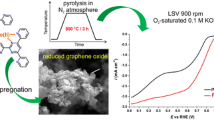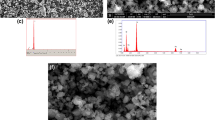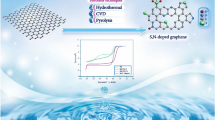Abstract
The novel mixed metal oxide (MMO) coatings of TiO2–RuO2 modified with graphene oxide (GO)/reduced graphene oxide (rGO) nanosheets were synthesized and investigated on the Ti substrate by the sol–gel approach. Central composite design (CCD) and response surface methodology (RSM) were used to simulate and optimize the graphene compounds additive in the coating. The slope difference in the transpassive region at NaCl and H2SO4 solutions was considered as the significant factor for the selectivity of anode between the competitive evolution reactions of oxygen and chlorine. In order to characterize the coating, XRD, FTIR, FESEM, TEM, AFM tests, CV, polarization, and EIS curves were carried out. The obtained optimal condition included the GO concentration of 0.56 mg ml−1, the rGO concentration of about 0.56 mg ml−1, and the layers number of 4. It was predicted that the optimal selectivity of the graphene modified electrode is approximately 83.189, which was measured to be about 84.944 at the reproducible level. Indeed, the model for simulating the graphene modification was suitable and reliable.

Highlights
-
DSA electrocatalyst coatings modified with GO/rGO nanosheets on the titanium substrate were synthesized by sol–gel method using the experimental design.
-
Simulation and optimization of the amount of GO/rGO additives to the coating and number of applied coating layers on the selectivity property of anodic reactions of the DSA electrode were done by CCD and RSM method.
-
The difference in slope of the transpassive region in NaCl + H2SO4 solutions was considered as the important factor in the selectivity of anode between competitive evolution reactions of chlorine and oxygen at the electrode surface, and the optimal DSA coating conditions including GO/rGO were obtained by the proposed model.
-
TOF measurements and GC-MS analysis confirmed that the use of GO and rGO has improved the intrinsic electrocatalytic properties accompanied by an electrochemically active surface area of electrodes.











Similar content being viewed by others
References
Yi Z, Xinxin Z, Yujie Z (2009) Ti-based anodes with metal oxide coatings. Prog Chem 21(9):1827–1831
Bespalova ZI, Ivanov VV, Smirnitskaya IV, Fesenko LN, Kudryavtsev YD (2010) Fabrication of a titanium anode with an active coating based on mixed oxides of base metals. Russ J Appl Chem 83(2):242–246
Panić V, Dekanski A, Mišković Stanković VB, Milonjić S, Nikolić B (2005) On the deactivation mechanism of RuO2-TiO2/Ti anodes prepared by the sol-gel procedure. J Electroanal Chem 579(1):67–76
Panic V, Dekanski AB, Miskovic V (2003) The role of titanium oxide concentration profile of titanium oxide of RuO2-TiO2 coatings obtained by the sol-gel procedure on its electrochemical behavior. J Serb Chem Soc 68(12):979–988
Wei H, Wang G, Luo Y, Li D, Meng Q (2015) Investigation on interfacial charge transfer process in CdSexTe1-x alloyed quantum dot sensitized solar cells. Electrochim Acta 173:156–163
Li K, Wang XF, Zeng HC (1997) Kinetics of N2O decopmosition on a RuO2 /Al2O3 catalyst. Chem Eng Res Des 75(8):807–812
Chen R, Trieu V, Schley B, Natter H, Kintrup J, Bulan A, Weber R, Hempelmann R (2013) Anodic electrocatalytic coatings for electrolytic chlorine production: a review. Z für Phys Chem 227(i):651–666
Chen R, Trieu V, Zeradjanin AR, Natter H, Teschner D, Kintrup J, Bulan A, Schuhmann W, Hempelmann R (2012) Microstructural impact of anodic coatings on the electrochemical chlorine evolution reaction. Phys Chem Chem Phys 14(20):7392
Goudarzi M, Ghorbani M (2016) Deposition of (Ti, Ru)O2 and (Ti, Ru, Ir)O2 oxide coatings prepared by sol-gel method on titanium. J Sol-Gel Sci Technol 79(1):44–50
Panić V, Dekanski A, Wang G, Fedoroff M, Milonjić S, Nikolić B (2003) Morphology of RuO2-TiO2 coatings and TEM characterization of oxide sols used for their preparation. J Colloid Interface Sci 263(1):68–73
Goudarzi M, Ghorbani M (2014) A study on ternary mixed oxide coatings containing Ti, Ru, Ir by sol-gel method on titanium. J Sol-Gel Sci Technol 73(2):332–340
Aparicio M, Klein L (2004) Thin and thick RuO 2-TiO 2 coatings on titanium substrates by the sol-gel process. J Sol-Gel Sci Technol 29(2):81–88
Pouladvand I, Asl SK, Hoseini MG, Rezvani M (2019) Characterization and electrochemical behavior of Ti/TiO2–RuO2–IrO2–SnO2 anodes prepared by sol–gel process. J Sol-Gel Sci Technol 89(2):553–561. https://doi.org/10.1007/s10971-018-4887-4
Karlsson RKB (2015) Theoretical and experimental studies of electrode and electrolyte processes in industrial electrosynthesis. Stockholm, Sweden: KTH Royal Institute of Technology
Ardizzone S, Falciola M, Trasatti S (1989) Effect of the nature of the precursor on the electrocatalytic properties of thermally prepared ruthenium oxide. J Electrochem Soc 136(5):1545–1550
Gaudet J, Tavares aC, Trasatti S, Guay D (2005) Physicochemical characterization of mixed RuO2 -SnO2 solid solutions. Chem Mater 17:1570–1579
Yousefpour M, Shokuhy A (2012) Electrodeposition of TiO2–RuO2–IrO2 coating on titanium substrate. Superlattices Microstruct 51(6):842–853
Therese GHA, Kamath PV (2000) Electrochemical synthesis of metal oxides and hydroxides. Chem Mater 12(5):2000
Panić VV, Dekanski a, Milonjić SK, Atanasoski RT, Nikolić BŽ (1999) RuO2-TiO2 coated titanium anodes obtained by the sol-gel procedure and their electrochemical behaviour in the chlorine evolution reaction. Colloids Surf A Physicochem Eng Asp 157:269–274
Kristóf J, Horváth E, Daolio S (2013) Study of metal oxide electrocatalytic thin film evolution by thermoanalytical and spectroscopic techniques-a review. Electrocatalysis 4(4):196–202
Terezo AJ, Pereira EC (2002) Preparation and characterisation of Ti/RuO2 anodes obtained by sol–gel and conventional routes. Mater Lett 53(4–5):339–345
Hayfield P (1998) Development of the noble metal/oxide coated titanium electrode. Part 1: The Beginning of the Hystory. Platin Met Rev 42(3):27–33
Xiong K, Deng Z, Li L, Chen S, Xia M, Zhang L, Qi X, Ding W, Tan S, Wei Z (2013) Sn and Sb co-doped RuTi oxides supported on TiO2 nanotubes anode for selectivity toward electrocatalytic chlorine evolution. J Appl Electrochem 43(8):847–854
Abbott DF, Petrykin V, Okube M, Bastl Z, Mukerjee S, Krtil P (2015) Selective chlorine evolution catalysts based on Mg-doped nanoparticulate ruthenium dioxide. J Electrochem Soc 162(1):H23–H31
Kuznetsova E, Petrykin V, Sunde S, Krtil P (2015) Selectivity of nanocrystalline IrO2-based catalysts in parallel chlorine and oxygen evolution. Electrocatalysis 6(2):198–210
Košević M, Stopic S, Bulan A, Kintrup J, Weber R, Stevanović J, Panić V, Friedrich B (2017) A continuous process for the ultrasonic spray pyrolysis synthesis of RuO2/TiO2 particles and their application as a coating of activated titanium anode. Adv Powder Technol 28(1):43–49
Yan Z, Li G, Wang J, Zhang Z, Feng Z, Tang M, Zhang R (2016) Electrocatalytic study of IrO2-Ta2O5 coated anodes with pretreated titanium substrates. J Alloy Compd 680(36):60–66
Dao VD, Larina LL, Lee JK, Jung KD, Huy BT, Choi HS (2015) Graphene-based RuO2 nanohybrid as a highly efficient catalyst for triiodide reduction in dye-sensitized solar cells. Carbon N Y 81(1):710–719
Zeradjanin AR, La Mantia F, Masa J, Schuhmann W (2012) Utilization of the catalyst layer of dimensionally stable anodes—Interplay of morphology and active surface area. Electrochim Acta 82:408–414
Xu LK, Scantlebury JD (2003) Microstructure and electrochemical properties of IrO2-Ta2O5-coated titanium anodes. J Electrochem Soc 150(6):B254–B261
Kyzas GZ, Deliyanni EA, Bikiaris DN, Mitropoulos AC (2018) Graphene composites as dye adsorbents: review. Chem Eng Res Des 129:75–88
Cho YJ, Il Kim H, Lee S, Choi W (2015) Dual-functional photocatalysis using a ternary hybrid of TiO2 modified with graphene oxide along with Pt and fluoride for H2-producing water treatment. J Catal 330:387–395
Chen P (2017) Synthesis and photocatalysis of novel magnetic reduced graphene oxide-ZnFe2O4nanocomposites with highly efficient interface-induced effect. J Sol-Gel Sci Technol 82(2):397–406
Zahed M, sadat Parsamehr P, Tofighy MA, Mohammadi T (2018) Synthesis and functionalization of graphene oxide (GO) for salty water desalination as adsorbent. Chem Eng Res Des 138:358–365
Jukk K, Kongi N, Rauwel P, Matisen L, Tammeveski K (2016) Platinum nanoparticles supported on nitrogen-doped graphene nanosheets as electrocatalysts for oxygen reduction reaction. Electrocatalysis 7(no. 5):428–440
Zong J, Jin Q, Huang C (2013) Effect of wetted graphene on the performance of Pt/PPy-graphene electrocatalyst for methanol electrooxidation in acid medium. J Solid State Electrochem 17(5):1339–1348
Royaei N, Shahrabi T, Yaghoubinezhad Y (2018) The investigation of the electrocatalytic and corrosion behavior of a TiO2–RuO2 anode modified by graphene oxide and reduced graphene oxide nanosheets via a sol–gel method. Catal Sci Technol 8:4957–4974
Spasojević M, Krstajić N, Spasojević P, Ribić-Zelenović L (2015) Modelling current efficiency in an electrochemical hypochlorite reactor. Chem Eng Res Des 93:591–601
Arikawa T, Murakami Y, Takasu Y (1998) Simultaneous determination of chlorine and oxygen evolving at RuO2/Ti and RuO2-TiO2/Ti anodes by differential electrochemical mass spectroscopy. J Appl Electrochem 28(5):511–516
Yue H, Xue L, Chen F (2017) Efficiently electrochemical removal of nitrite contamination with stable RuO2-TiO2/Ti electrodes. Appl Catal B Environ 206:683–691
Karlsson RKB, Cornell A (2016) Selectivity between Oxygen and chlorine evolution in the chlor-alkali and chlorate processes. Chem Rev 116(5):2982–3028
Box GEP, Hunter WG, Hunter JS (2005) Statistics for experimenters: an introduction to design, data analysis, and model building. Wiley Ser Probab Math Stat 1(2):528–529
Latchubugata CS, Kondapaneni RV, Patluri KK, Virendra U, Vedantam S (2018) Kinetics and optimization studies using response surface methodology in biodiesel production using heterogeneous catalyst. Chem Eng Res Des 135:129–139
Aziz MA, Mahmoud TS, Aal AA (2008) Modeling and optimizing of factors affecting erosion-corrosion of AA6063-(TiC/Al2O3) hybrid composites by experimental design method. Mater Sci Eng A 486(1–2):313–320
Rebollar M, Yates M, Valenzuela MA (2000) Application of experimental design for NOx reduction by Pd-Cu catalysts. Sci Bases Prep Heterog Catal 143:407–414
Rostamiyan Y, Fereidoon A, Rezaeiashtiyani M, Mashhadzadeh AH, Salmankhani A (2015) Experimental and optimizing flexural strength of epoxy-based nanocomposite: effect of using nano silica and nano clay by using response surface design methodology. Mater Des 69:96–104
Asghari E, Ashassi-Sorkhabi H, Ahangari M, Bagheri R (2016) Optimization of a three-component green corrosion inhibitor mixture for using in cooling water by experimental design. J Mater Eng Perform 25(4):1416–1425
Montogomery DC (2012) Design and Analysis of Experiments, Sixth. John Wiley & Sons, Inc.
Leng X, Zou J, Xiong X, He H (2015) Electrochemical capacitive behavior of RuO2/graphene composites prepared under various precipitation conditions. J Alloy Compd 653:577–584
Gao Y, Pu X, Zhang D, Ding G, Shao X, Ma J (2012) Combustion synthesis of graphene oxide–TiO2 hybrid materials for photodegradation of methyl orange. Carbon N Y 50(11):4093–4101
Panic VV, Nikolic B (2008) Electrocatalytic properties and stability of titanium anodes activated by the inorganic sol-gel procedure. J Serb Chem Soc 73(11):1083–1112
Shrivastava P, Moats MS (2009) Wet film application techniques and their effects on the stability of RuO2-TiO2 coated titanium anodes. J Appl Electrochem 39(1):107–116
Bezerra MA, Santelli RE, Oliveira EP, Villar LS, Escaleira LA (2008) Response surface methodology (RSM) as a tool for optimization in analytical chemistry. Talanta 76(5):965–977
Khuri AI, Mukhopadhyay S (2010) Response surface methodology. Wiley Interdiscip Rev Comput Stat 2(2):128–149
Kosari A, Davoodi A, Moayed MH, Gheshlaghi R (2015) The response surface method as an experimental design technique to explore and model the performance of corrosion inhibitors. Corrosion 71(7):819–827
Trieu V, Schley B, Natter H, Kintrup J, Bulan A, Hempelmann R (2012) RuO 2-based anodes with tailored surface morphology for improved chlorine electro-activity. Electrochim Acta 78:188–194
Sjöblom J, Papadakis K, Creaser D, Odenbrand CUI (2005) Use of experimental design in development of a catalyst system. Catal Today 100(3–4):243–248
Hu JM, Zhang JQ, Cao CN (2004) Oxygen evolution reaction on IrO2-based DSA type electrodes: Kinetics analysis of Tafel lines and EIS. Int J Hydrog Energy 29(8):791–797
Audichon T, Mayousse E, Morisset S, Morais C, Comminges C, Napporn TW, Kokoh KB (2014) Electroactivity of RuO2–IrO2 mixed nanocatalysts toward the oxygen evolution reaction in a water electrolyzer supplied by a solar profile. Int J Hydrog Energy 39(30):16785–16796
Leng X, Liu R, Zou J, Xiong X, He H (2016) One-pot hydrothermal synthesis of graphene-RuO2-TiO2 nanocomposites. Mater Lett 166:175–178
Cho K, Hoffmann MR (2017) Molecular hydrogen production from wastewater electrolysis cell with multi-junction BiOx/TiO2 anode and stainless steel cathode: current and energy efficiency. Appl Catal B Environ 202:671–682
Arikado T, Iwakura C, Tamura H (1978) Some oxide catalysts for the anodic evolution of chlorine: reaction mechanism and catalytic activity. Electrochim Acta 23(1):9–15
Chen J, Yao B, Li C, Shi G (2013) An improved Hummers method for eco-friendly synthesis of graphene oxide. Carbon N Y 64(1):225–229
Menzel R, Iruretagoyena D, Wang Y, Bawaked SM, Mokhtar M, Al-Thabaiti SA, Basahel SN, Shaffer MSP (2016) Graphene oxide/mixed metal oxide hybrid materials for enhanced adsorption desulfurization of liquid hydrocarbon fuels. Fuel 181:531–536
Panić V, Dekanski A, Mišković-Stanković VB, Nikolić B, Milonjić S (2005) The rol of sol-gel procedure conditions in electrochemical behaviour and corrosion stability of Ti/[RuO2 -TiO2] anodes. Mater Manuf Process 20(1):89–103
Jovanović VM, Dekanski A, Despotov P, Nikolić BŽ, Atanasoski RT (1992) The roles of the ruthenium concentration profile, the stabilizing component and the substrate on the stability of oxide coatings. J Electroanal Chem 339(1–2):147–165
Yu L, Lei T, Nan B, Jiang Y, He Y, Liu CT (2016) Characteristics of a sintered porous Ni e Cu alloy cathode for hydrogen production in a potassium hydroxide solution. Energy 97:498–505
Deshmukh PR, Pusawale SN, Jagadale AD, Lokhande CD (2012) Supercapacitive performance of hydrous ruthenium oxide (RuO 2.nH 2O) thin films deposited by SILAR method. J Mater Sci 47(3):1546–1553
H. M DS, Sanchez C (1987) Hydrolysis Titan alkoxides: Modif Mol precursor acetic Acid 89(1–2):206–216
Li F, Zhang L, Li J, Lin X, Li X, Fang Y (2015) Synthesis of Cu e MoS 2/rGO hybrid as non-noble metal electrocatalysts for the hydrogen evolution reaction. J Power Sources 292:15–22
Mccrory CCL, Jung S, Peters JC, Jaramillo TF (2013) Benchmarking heterogeneous electrocatalysts for the oxygen evolution reaction. J Am Chem Soc 135(no. 45):16977–16987
Colomer MT, Velasco MJ, Jurado JR, Venezia U, Marta CLS, Debattisti A (2006) Synthesis and thermal evolution of TiO2-RuO2 xerogels. J Sol-Gel Sci Technol 39(3):211–222
Seddon EA and Seddon KR, The Chemistry of Ruthenium. Elsevier B.V., 1984
Atanasoska LL, Cullen DA, Atanasoski RT (2013) XPS and STEM study of the interface formation between ultra-thin Ru and Ir OER catalyst layers and Perylene Red support whiskers. J Serb Chem Soc 78(no. 12):1993–2005
Ge Q, Desai S, Neurock M, Kourtakis K (2001) CO adsorption on Pt - Ru surface alloys and on the surface of Pt - Ru bulk alloy J Phys Chem B 105(39):9533–9536
Gao MY, Yang C, Zhang QB, Yu YW, Hua YX, Li Y, Dong P (2016) Electrochimica Acta Electrochem Fabr Porous Ni-Cu Alloy nanosheets High Catal Act Hydrog Evol 215:609–616
Malfatti L, Carboni D, Pinna A, Lasio B, Marmiroli B, Innocenzi P (2016) In situ growth of Ag nanoparticles in graphene–TiO2 mesoporous films induced by hard X-ray. J Sol-Gel Sci Technol 79(2):295–302
Ardizzone S, Fregonara G, Trasatti S (1990) ‘Inner’ and ‘outer’ active surface of RuO2 electrodes. Electrochim Acta 35(1):263–267
Bulan RHA, Kintrup J, Weber R, Chen R, Trieu V, Natter H, Elektrode für die elektrolytische Chlorherstellung DE 10 2010 043 085A, 2010
Arbiol J, Cerdda J, Dezanneau G, Cirera A, Dezanneau JR, Morante G (2002) Effects of Nb doping on the TiO 2 anatase-to-rutile phase transition. J Appl Phys 92(2):853–861
Zheng XD, Ren F, Cai GX, Hong MQ, Xiao XH, Wu W, Liu YC, Li WQ, Ying JJ, Jiang CZ (2014) Formation of TiO 2 nanorods by ion irradiation. J Appl Phys 115(18):184306
Ribeiro J, Andrade ARDe (2004) Characterization of RuO2-Ta2O5 coated titanium electrode microstructure, morphology, and electrochemical investigation. J Electrochem Soc 151(10):D106
Martelli GN, Ornelas R, Faita G (1994) Deactivation mechanisms of oxygen evolving anodes at high current densities. Electrochim Acta 39(11–12):1551–1558
Leng X, Liu R, Zou J, Xiong X, He H (2016) One-pot hydrothermal synthesis of graphene–RuO2–TiO2 nanocomposites. Mater Lett 166:175–178
Xiong K, Peng L, Wang Y, Liu L, Deng Z, Li L, Wei Z (2016) In situ growth of RuO2–TiO2 catalyst with flower-like morphologies on the Ti substrate as a binder-free integrated anode for chlorine evolution. J Appl Electrochem 46(8):841–849
Evdokimov SV (2000) Corrosion behavior of dimensionally stable anodes in chlorine electrolyses. Russ J Electrochem 36(3):259–264
Acknowledgements
This research work was financially supported by the Iran National Science Foundation (INSF) and the Iran Nanotechnology Initiative Council (INIC).
Author information
Authors and Affiliations
Corresponding authors
Ethics declarations
Conflict of interest
The authors declare that they have no conflict of interest.
Additional information
Publisher’s note: Springer Nature remains neutral with regard to jurisdictional claims in published maps and institutional affiliations.
Rights and permissions
About this article
Cite this article
Royaei, N., Shahrabi, T. & Yaghoubinezhad, Y. Optimization the selectivity property of graphene oxide modified dimensionally stable anode (DSA) produced by the sol–gel method. J Sol-Gel Sci Technol 90, 547–564 (2019). https://doi.org/10.1007/s10971-019-04966-9
Received:
Accepted:
Published:
Issue Date:
DOI: https://doi.org/10.1007/s10971-019-04966-9




